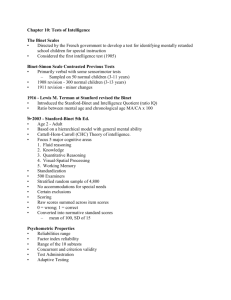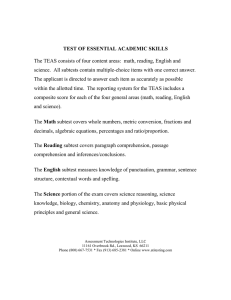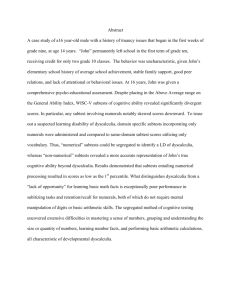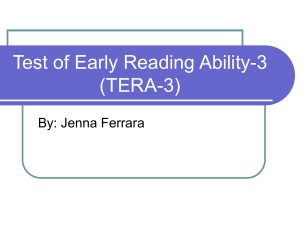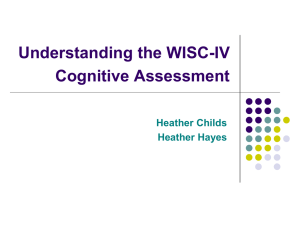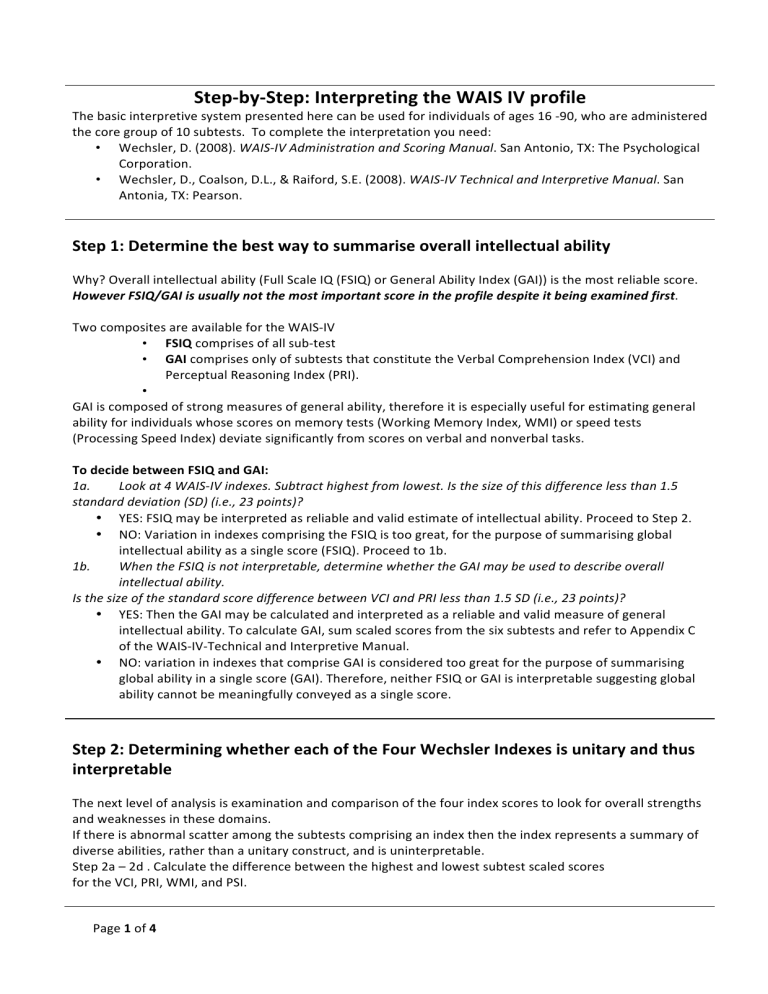
Step-by-Step: Interpreting the WAIS IV profile The basic interpretive system presented here can be used for individuals of ages 16 -90, who are administered the core group of 10 subtests. To complete the interpretation you need: • Wechsler, D. (2008). WAIS-IV Administration and Scoring Manual. San Antonio, TX: The Psychological Corporation. • Wechsler, D., Coalson, D.L., & Raiford, S.E. (2008). WAIS-IV Technical and Interpretive Manual. San Antonia, TX: Pearson. Step 1: Determine the best way to summarise overall intellectual ability Why? Overall intellectual ability (Full Scale IQ (FSIQ) or General Ability Index (GAI)) is the most reliable score. However FSIQ/GAI is usually not the most important score in the profile despite it being examined first. Two composites are available for the WAIS-IV • FSIQ comprises of all sub-test • GAI comprises only of subtests that constitute the Verbal Comprehension Index (VCI) and Perceptual Reasoning Index (PRI). • GAI is composed of strong measures of general ability, therefore it is especially useful for estimating general ability for individuals whose scores on memory tests (Working Memory Index, WMI) or speed tests (Processing Speed Index) deviate significantly from scores on verbal and nonverbal tasks. To decide between FSIQ and GAI: 1a. Look at 4 WAIS-IV indexes. Subtract highest from lowest. Is the size of this difference less than 1.5 standard deviation (SD) (i.e., 23 points)? • YES: FSIQ may be interpreted as reliable and valid estimate of intellectual ability. Proceed to Step 2. • NO: Variation in indexes comprising the FSIQ is too great, for the purpose of summarising global intellectual ability as a single score (FSIQ). Proceed to 1b. 1b. When the FSIQ is not interpretable, determine whether the GAI may be used to describe overall intellectual ability. Is the size of the standard score difference between VCI and PRI less than 1.5 SD (i.e., 23 points)? • YES: Then the GAI may be calculated and interpreted as a reliable and valid measure of general intellectual ability. To calculate GAI, sum scaled scores from the six subtests and refer to Appendix C of the WAIS-IV-Technical and Interpretive Manual. • NO: variation in indexes that comprise GAI is considered too great for the purpose of summarising global ability in a single score (GAI). Therefore, neither FSIQ or GAI is interpretable suggesting global ability cannot be meaningfully conveyed as a single score. Step 2: Determining whether each of the Four Wechsler Indexes is unitary and thus interpretable The next level of analysis is examination and comparison of the four index scores to look for overall strengths and weaknesses in these domains. If there is abnormal scatter among the subtests comprising an index then the index represents a summary of diverse abilities, rather than a unitary construct, and is uninterpretable. Step 2a – 2d . Calculate the difference between the highest and lowest subtest scaled scores for the VCI, PRI, WMI, and PSI. Page 1 of 4 Highest 2a VCI subtests 2b PRI subtest 2c WMI subtest 2d PSI subtests Lowest - Difference = = = = Is the difference < 5 points? Y or N Y or N Y or N Y or N Is the size of this difference less than 1.5SD (i.e. <5 points)? YES: the ability presumed to underlie the index is unitary and may be interpreted NO: Then the difference is too large and VCI cannot be interpreted as representing a unitary ability. Step 3: Evaluate Index level Discrepancy Comparisons Is there a significant difference between performance on the Indexes? Is this difference unusual in the general population? 3a. The first step in performing a pair-wise comparison is to determine if the absolute value of the score difference is statistically significant. • Refer to Table B.1 of the WAIS-IV Administration and Scoring Manual which provides the minimum difference between index scores required for statistical significance, by age. Use the 0.05 criterion. • When the absolute value of the obtained difference is equal to or larger than the critical value, the difference is considered a true difference, rather than a difference due to measurement error or random fluctuation. 3b. For all significant differences between index scores, the next step is to judge how rare the difference is in the general population. • Refer to Table B.2 of the WAIS-IV Administration and Scoring Manual, which provides the cumulative frequency (i.e. base rates) of discrepancies among the WAIS-IV scores in the normative sample. • The tables provide base rate data by overall normative sample and ability level (as the frequency of index score discrepancies varies widely across different levels of intellectual ability). • What constitutes an unusual discrepancy? Typically, if the discrepancy occurs in less than 10% of population it is considered unusual, but the ‘percent’ used is up to professional judgement. Step 4: Determine Normative Strengths and Normative Weaknesses in the Index profile Only unitary Wechsler indexes are included in this analysis • If the index is greater than 115, the ability measured by the index is a normative strength • If the index or factor score is less than 85, the ability measured by the index is a normative weakness • If the Index is between 85 and 115, (inclusive) the ability measured by the Index is within normal limits Step 5: Evaluate Personal Strengths and Weaknesses • Most individuals have areas of cognitive strength and weakness. In fact, it is very uncommon for the Page 2 of 4 average person to function at the same level in every ability area. • Normative strengths and weaknesses (i.e., Step 4) indicate a person’s abilities by comparison to individuals of the same age. • In contrast, personal strengths and weaknesses refer to whether a person’s scaled scores on individual subtests differ significantly from their average performance across tests. • Table B.5 of the WAIS-IV Administration and Scoring manual provides the minimum difference between a single subtest and the average of subtest scaled scores required for statistical significance. (Use the 0.05 criterion) • This table also provides the base rate data (or cumulative frequencies) for differences between a single subtest and either the overall mean of subtests contributing to the FSIQ, or the three subtests contributing to the VCI and PRI. • The values in Table B.5 are based on means derived from administration of the core subtests. • The values in this table may be used, with caution, to evaluate an individual’s strengths and weaknesses if an allowable subtest substitution was made – but the possible introduction of additional measurement error should be evaluated and noted in the report. Decide whether to: • Use the mean score of the ten subtests used to derive the FSIQ: Chose if there is no significant discrepancy among the index scores, the mean of the 10 core subtests should be used for the strengths and weaknesses analysis • Use the mean of the three Verbal Comprehension (VCI) and three Perceptual Reasoning (PRI) subtests separately. Chose if there is significant discrepancy among the index scores If you chose separate means: • The mean of the three Verbal Comprehension subtests is the basis against which each Verbal Comprehension subtest score is compared • The mean of the three Perceptual Reasoning subtests is the basis against which each Perceptual Reasoning subtest is compared. • In this instance it is not possible to evaluate the strengths and weaknesses associated with Working Memory and Processing Speed subtests. • Determine whether Personal strengths and weaknesses are uncommon using the less than 10% base rate criterion • Use this information to interpret fluctuations in Index or Factor profile Step 6: Evaluate Subtest-Level Discrepancy Comparisons • • • In some situations, the examiner may wish to compare two subtest scores. For example, comparison of performance on Digit Span and Arithmetic subtests may inform interpretation of the WMI score (Kaufman & Lichtenberger, 2006), and provide useful information regarding the examinee’s auditory rote memory and quantitative reasoning when facility with numbers is required. The record form provides space to perform the pair-wise comparisons relevant to interpreting the WMI and PSI: the Digit Span to Arithmetic comparison and the Symbol Search to Coding comparison. Refer to Table B.3 in the WAIS-IV Administration and Scoring Manual for determining the significance of the difference (at the 0.05 level), and Table B.4 for base rates in the normative sample. Step 7: Generate hypotheses about any fluctuations in the WAIS-IV profile • Page 3 of 4 Integrate psychometric data with your behavioural observations, client’s history & background information, and other sources of information. Further testing may be necessary to prove your hypotheses. Page 4 of 4
